|
Continued from
FrontPage of Article
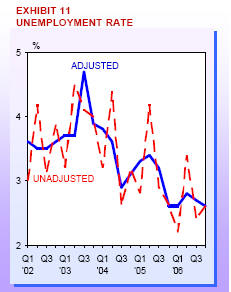
Labour Market
Total employment grew strongly by 48,800
in 4Q06, higher than the 43,000 in 3Q06.
The bulk of the gains continued to come
from services (32,300) while manufacturing and construction also
posted increases in employment. During the quarter, 3,000 workers
were laid off, higher than the 2,435 retrenched in 3Q06.
Seasonallyadjusted unemployment rate fell slightly from 2.7% in
September 2006 to 2.6% in December 2006.
Over the year, total employment creation
reached an all-time high of 173,300, surpassing 113,300 in the
previous year.
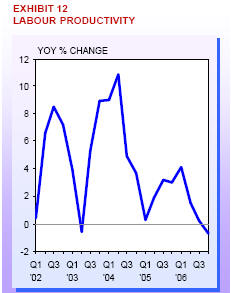
Labour Productivity
Labour productivity in 4Q06 declined by
0.7% as employment gains outpaced GDP growth.
At the sectoral level, business services
saw the largest drop in productivity levels (-5.1%), followed by
construction (-3.3%), information and communications (-3.0%), hotels
and restaurants (-2.4%) and manufacturing (-0.7%) sectors. On the
other hand, the other sectors registered positive growth in
productivity, viz, wholesale and retail trade (1.8%), financial
services (1.6%) and transport and storage (0.5%).
For 2006, productivity growth slowed
from 2.1% in 2005 to 1.2% in 2006.

Business Costs
Unit labour Cost (ULC) of the overall
economy increased by a marginal 0.1% in 4Q06, following a 1.5%
increase in 3Q06.
For the whole of 2006, ULC was down by
0.5%, a smaller decline compared to the previous year. Unit business
cost (UBC) in the manufacturing sector went up by 2.4% in 4Q06. Over
2006, UBC rose by 0.6%, after remaining flat a year earlier. The
3.6% fall in manufacturing ULC was offset by the increases in
services costs (mainly utilities and rental) and government rates &
fees (mainly property prices).
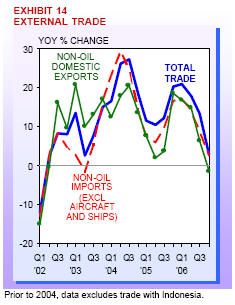
External Trade
Singapore¡¯s external trade expanded by
3.0% in 4Q06, down from the 13% in 3Q06.
Growth of total exports slowed to 2.0%
after a 12% increase a quarter earlier, as both oil and non-oil
domestic exports (NODX) declined while growth of re-exports
moderated. Non-oil imports (excluding aircraft and ships) rose 2.6%,
after posting 8.5% growth in 3Q06. In volume terms, total trade
increased by 5.2%, compared to 11% in the previous quarter.
Over 2006, external trade expanded by
13% while NODX growth edged up to 8.5% from 8.2% in 2005.
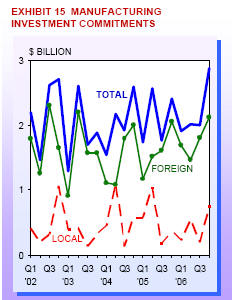
Investment Commitments
In 4Q06, manufacturing investment
commitments totalled $2.9 billion in terms of fixed assets. This
brought total manufacturing investment commitments for the whole
year to $8.8 billion, a 3.8% increase over the previous year. When
fully operational, these commitments would generate a value added of
almost $7 billion per annum and create 16,200 jobs, of which 56%
would be for skilled workers.
Total business spending commitments in
services promoted by EDB amounted to $714 million in 4Q06. For the
whole of 2006, commitments in these services industries were $2.8
billion, up from $2.5 billion a year earlier. When fully realised,
these commitments would generate a value added of $6.5 billion per
annum and create 10,600 jobs. 77% of these jobs would be for skilled
workers.
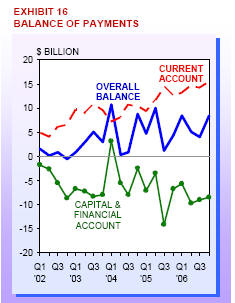
Balance of Payments
Singapore¡¯s overall balance of payments
registered a larger surplus of $8.5 billion in 4Q06 compared with
$4.0 billion in the previous quarter.
This brought the overall balance of
payments for the whole of 2006 to $26 billion, compared to $20
billion in 2005. This largely reflected the larger current account
surplus which offset the capital and financial account outflow
during the year. Consequently, Singapore¡¯s official foreign reserves
rose to $211 billion as at end-2006.
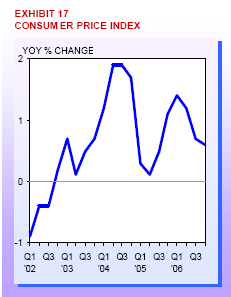
Consumer Price Inflation
The CPI rose by 0.6% year-on-year in
4Q06, compared to 0.7% in 3Q06.
The categories which saw the largest
increase were food (1.6%) and education & stationery (1.5%), and
housing (1.3%). However, prices of clothing & footwear dipped
slightly (-0.2%) while costs of transport & communications fell by
1.6%. For the whole year, consumer price inflation rose 1.0%, up
from 0.5% in 2005. Among all the categories, housing cost registered
the largest annual increase (2.7%), due mainly to higher electricity
tariffs.
¡¡
Outlook for 2007
The global economic conditions have
improved over the last few months. In the US, fears of the housing
market correction spilling over to the wider economy have subsided
with a pickup in housing sales. Prospects for the EU are healthy,
supported by strong business confidence. In Asia, China and India
are expected to see continued strong growth, while the outlook for
Japan remains favourable on the back of stronger corporate profits.
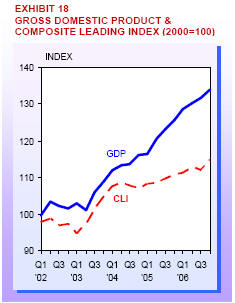
Oil prices have fallen from its peak in
2006 amid weeks of mild winter weather in the US and larger than
expected increases in oil inventories. In the electronics industry,
the inventory correction is improving. Research house Gartner has
forecast worldwide semiconductor sales to grow by a healthy 9.2% in
2007, following the 10.4% growth in 2006.
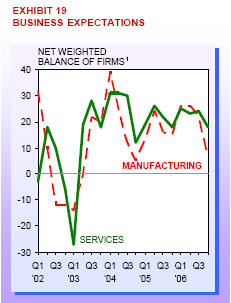
1 The y-axis of the chart on
business expectations represents the net weighted balance of
companies that predict an improvement in business situation. This is
derived from the weighted percentage of companies in the survey that
predict better business minus the weighted percentage of companies
that predict worse business.
On the domestic front, forward looking
indicators point towards continued growth in the next few quarters.
The composite leading index recovered from a dip in the third
quarter, rising to its highest level in the fourth quarter. The
latest surveys of business expectations also show that firms in the
manufacturing and services remain optimistic about business
conditions in the next 6 months.
Although the economic outlook is
generally positive, some downside risks persist. An Avian flu
pandemic threat has resurfaced as a growing number of countries
reported cases of infection in birds in recent weeks. Other
uncertainties include the disorderly unwinding of global imbalances,
terrorism and the vulnerability of oil prices to supply shocks.
Taking into account the above factors,
the Ministry of Trade and Industry has revised the 2007 economic
growth forecast from 4.0-6.0% to 4.5-6.5%.
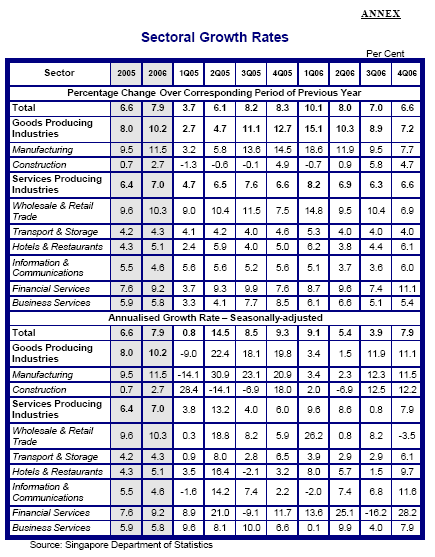
Source:
www.mti.gov.sg News Release 15 Feb
2007

¡¡
|